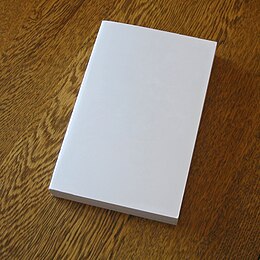
Back Sagteband AF كتاب ذو غلاف ورقي Arabic নরম মলাটের বই Bengali/Bangla Enquadernació en rústica Catalan Paperback Danish Κάλυμμα Greek Poŝlibro EO Encuadernación de tapa blanda Spanish شومیز FA Taskukirja Finnish


A paperback (softcover, softback) book is one with a thick paper or paperboard cover, and often held together with glue rather than stitches or staples. In contrast, hardback (hardcover) books are bound with cardboard covered with cloth, leather, paper, or plastic.
Inexpensive books bound in paper have existed since at least the 19th century in such forms as pamphlets, yellowbacks, dime novels, and airport novels.[1] Modern paperbacks can be differentiated from one another by size. In the United States, there are "mass-market paperbacks" and larger, more durable "trade paperbacks". In the United Kingdom, there are A-format, B-format, and the largest C-format sizes.[2]
Paperback editions of books are issued when a publisher decides to release a book in a low-cost format. Lower-quality paper, glued (rather than stapled or sewn) bindings, and the lack of a hard cover may contribute to the lower cost of paperbacks. In the early days of modern paperbacks, the 1930s and 1940s, they were sold as a cheaper, less permanent, and more convenient alternative to traditional hardcover books, as the name of the first American paperback publisher, Pocket Books, indicates. In addition, the Pocket Books edition of Wuthering Heights, one of the first ten books it published in 1939, emphasized the impermanence of paperbacks by telling readers if you "enjoyed it so much you may wish to own it in a more permanent edition", they could return the 25 cent book to Pocket Books with an additional 70 cents and it would send them a copy of the 95 cent Modern Library edition "substantially bound in durable cloth."[3]
Since the mid-20th century, paperbacks can also be the preferred medium when a book is not expected to be a major seller and the publisher wishes to release the book without a large investment. Examples include many novels and newer editions or reprintings of older books.
Because paperbacks tend to have smaller profit margins, many publishers try to balance the profit to be made by selling fewer hardcovers against the potential profit to be made by selling more paperbacks with a smaller profit per unit. First editions of many modern books, especially genre fiction, are issued in paperback. Best-selling books, on the other hand, may maintain sales in hardcover for an extended period to reap the greater profits that the hardcovers provide.[citation needed]
- ^ See, for example, the Tauchnitz editions.
- ^ Wilson-Fletcher, Honor (11 August 2001). "Why Size Matters". The Guardian. London. Retrieved 16 November 2006.
- ^ "Did You Like This Book?", Emily Brontë, Wuthering Heights, Pocket Books, New York, 1939, n.p.